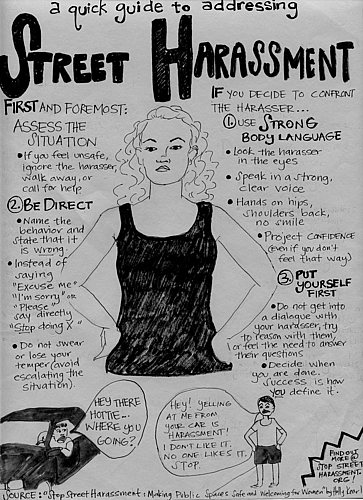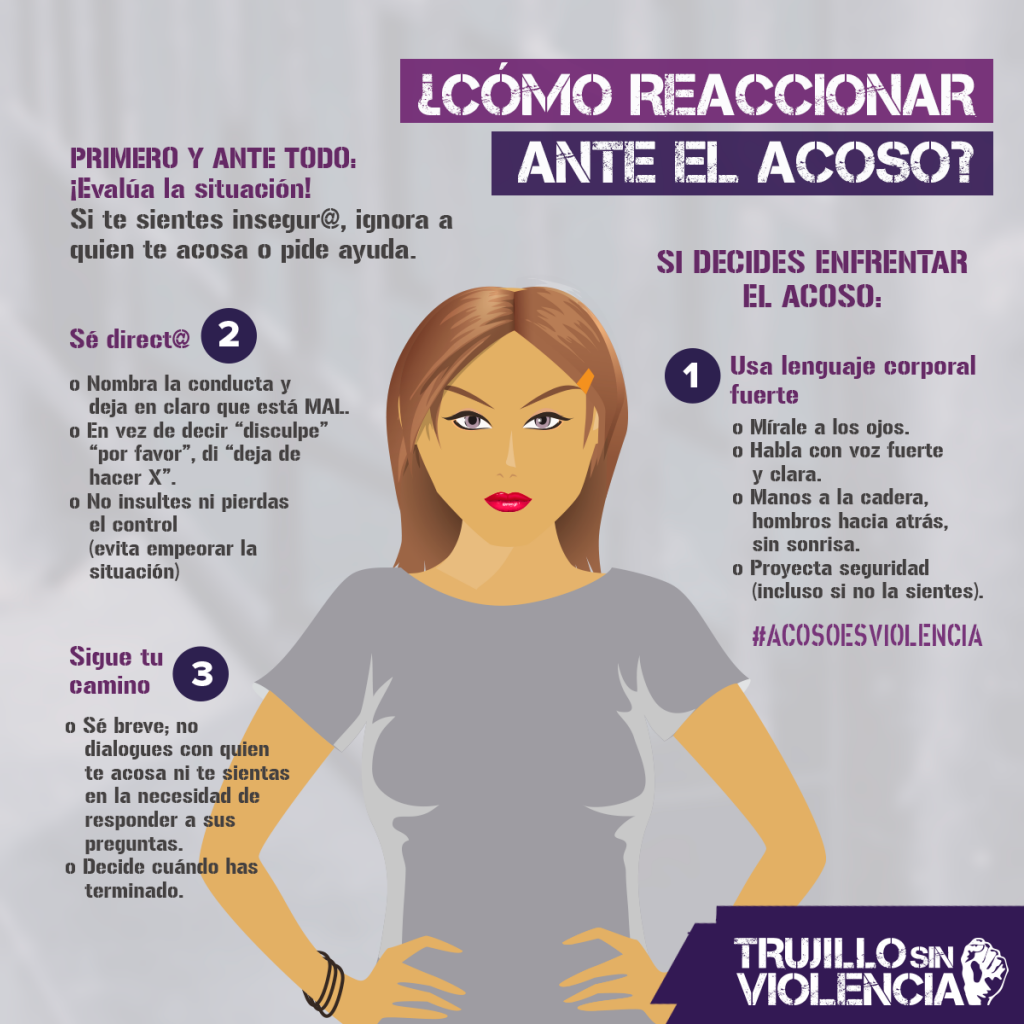
~ en español ~
There is no overall “best” way to respond to every harasser in every circumstance, and the harassed person is the only ones who can determine what the best way is for them to respond in any given incident so they will feel both safe and empowered. The more informed they are about options for responding, the better they can be at making that decision.
Below is a list of ideas for responses women can use that hold harassers accountable for their behavior. They are informed by experts Martha Langelan,1 Lauren R. Taylor,2 and Dr. Bernice Sandler.3
Since a street harassment incident can be startling and throw women off balance, practicing these responses aloud and role playing scenarios can help women feel more able to actually use them.
Additionally, here are stories from 20 women who felt they were able to stand up to their harassers in an empowering way and SSH’s new book 50 Stories about Stopping Street Harassers ($9 on Amazon).

Six suggestions for how to talk to a harasser:
1. Use strong body language. Look the harasser in the eyes; speak in a strong, clear voice. Using your voice, facial expressions, and body language together, without mixed signals, show assertiveness and strength.
2. Project confidence and calm. Even if you do not feel that way, it is important to appear calm, serious, and confident.
3. Do not apologize, make an excuse, or ask a question. You do not need to say sorry for how you feel or what you want. Be firm.
4. You do not need to respond to diversions, questions, threats, blaming, or guilt-tripping. Stay on your own agenda. Stick to your point. Repeat your statement or leave.
5. Do not swear or lose your temper: This type of reaction is the most likely to make the harasser respond with anger and violence.
6. Decide when you’re done. Success is how you define it. If you said what you needed to say and you’re ready to leave, do so.

Twelve ideas for what you can say to a harasser:
1. Name the behavior and state that it is wrong. For example say, “Do not whistle at me, that is harassment,” or “Do not touch my butt, that is sexual harassment.”
2. Tell them exactly what you want. Say, for example, “move away from me,” “stop touching me,” or “go stand over there.”
3. Ask them if they would want their mother, sister, daughter, girl friend, wife treated like they are treating you.
4. Make an all-purpose anti-harassment statement, such as: “Stop harassing women. I don’t like it. No one likes it. Show some respect.” Speak it in a neutral but assertive tone.
5. Use an A-B-C statement (and be very concrete about A and C): Tell the harasser what the problem is; State the effect; and What you want. Here is an example: “When you make kissing noises at me it makes me feel uncomfortable. I want you to say, ‘Hello, ma’am,’ from now on if you want to talk to me.”
6. Identify the perpetrator: “Man in the yellow shirt, stop touching me.” (This is especially useful if other people are nearby, like on a bus).
7. Attack the behavior, not the person. Tell them what they are doing that you do not like (“You are standing too close”) rather than blaming them as a person (“You are such a jerk”).
8. Use the “’Miss Manners’ Approach” and ask the harasser something like, “I beg your pardon!” or “I can’t believe you said that,” or “You must have me confused with someone to whom you think you can speak that way,” combined with facial expressions of shock, dismay, and disgust.
9. Ask a Socratic question such as, “That’s so interesting – can you explain why you think you can put your hand on my leg?”
10. If the harasser is in a car, write down the license plate of the car. Even if you can’t see it, pretending to write it down can scare the perpetrator into stopping. If the harassers are aggressive or threatening and you do write down the license plate number, you can report them to the police.
11. Buy a notebook and write in bold letters on the cover “Street Harassment.” Take out the notebook when you are harassed and ask the harasser to repeat himself so you can write it down. Make a big show of asking for the date, time, checking the place you are at, etc. If they ask why you’re writing things down, you can say you are keeping a record of harassment.
12. Tell the harasser that you are conducting a street harassment research project or survey. Take out a notebook and start asking them questions such as, “How often do you do this?” or “How do you choose which people to harass?” or “Are you more likely to do this when you are alone or when you’re with other people,” or “Do you discuss people you harass with your mother, sister, or female friends?”
The book Stop Street Harassment: Making Public Places Safe and Welcoming for Women includes further information on responding to harassers, including a number of examples and success stories.
Footnotes:
1. Martha Langelan, Back Off! How to confront and stop sexual harassment and harassers (New York: Fireside Press, 1993); see also Langelan, “Stop Right There!” Ms. Magazine, Fall 2005, p 39; see also Don’t be Silent Blog, “Highlights from the Martha Langelan Workshop,” February 10, 2008; see also Don’t Be Silent Blog, “Response to ‘Drive-by Hollas Drive Me Crazy!!’” February 11, 2008.
2. Lauren Taylor, “The Assertive Response to ‘Hey, Baby,’ Options Go Beyond the Silent Treatment,” Washington Post, October 27, 2003, C10; see also Lauren Taylor, “Speak Up! Basic Verbal Self Defense Guidelines,” Defend Yourself, n.d. (en espanol)
3. Bernice Sandler, “Handling Sexual Harassment When it Happens to You,” 1997.
